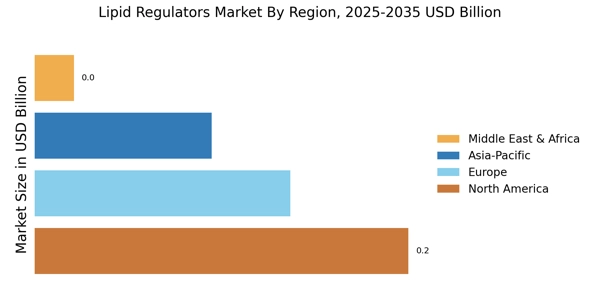Advancements in Drug Development
Innovations in drug development are significantly influencing the Lipid Regulators Market. The emergence of novel therapeutic agents, including PCSK9 inhibitors and other advanced lipid-lowering medications, has expanded treatment options for patients with dyslipidemia. These advancements not only enhance the efficacy of lipid management but also improve patient adherence to treatment regimens. Market data suggests that the introduction of these new drugs has the potential to capture a considerable market share, as they offer improved outcomes compared to traditional therapies. As research continues to evolve, the Lipid Regulators Market is expected to witness a surge in new product launches, further driving growth and competition among key players.
Growing Awareness of Cholesterol Management
There is a notable increase in public awareness regarding the importance of cholesterol management, which serves as a significant driver for the Lipid Regulators Market. Educational campaigns and health initiatives aimed at informing individuals about the risks associated with high cholesterol levels have led to a greater demand for lipid regulators. As more people seek preventive measures and treatment options, healthcare providers are likely to prescribe lipid-lowering medications more frequently. This heightened awareness is reflected in market trends, where the sales of lipid regulators have shown a steady upward trajectory. Consequently, the Lipid Regulators Market is poised for continued expansion as awareness campaigns persist.
Aging Population and Associated Health Issues
The demographic shift towards an aging population is a critical factor impacting the Lipid Regulators Market. Older adults are more susceptible to lipid disorders and cardiovascular diseases, necessitating effective management solutions. As the global population ages, the prevalence of conditions such as hyperlipidemia is expected to rise, leading to increased demand for lipid regulators. Market projections indicate that the aging demographic will significantly contribute to the growth of the Lipid Regulators Market, as healthcare systems adapt to meet the needs of this population. Pharmaceutical companies are likely to focus on developing targeted therapies that cater specifically to older patients, further driving market dynamics.
Regulatory Support for Lipid-Lowering Therapies
Regulatory bodies are increasingly supporting the development and approval of lipid-lowering therapies, which is a vital driver for the Lipid Regulators Market. Initiatives aimed at expediting the approval process for new medications and providing incentives for research and development are fostering innovation within the sector. This regulatory support not only encourages pharmaceutical companies to invest in lipid regulator research but also enhances patient access to effective treatments. As a result, the Lipid Regulators Market is likely to experience accelerated growth, with a diverse range of products entering the market. The favorable regulatory environment is expected to stimulate competition and drive advancements in lipid management solutions.
Increasing Prevalence of Cardiovascular Diseases
The rising incidence of cardiovascular diseases is a primary driver for the Lipid Regulators Market. As lifestyle-related factors such as poor diet, lack of physical activity, and obesity continue to escalate, the demand for lipid regulators is likely to increase. According to recent data, cardiovascular diseases account for a substantial percentage of global mortality, prompting healthcare systems to prioritize effective management strategies. This trend indicates a growing need for lipid-lowering therapies, which are essential in reducing cholesterol levels and preventing heart-related complications. Consequently, pharmaceutical companies are focusing on developing innovative lipid regulators to cater to this increasing demand, thereby propelling the Lipid Regulators Market forward.


















Leave a Comment